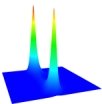Exciton-Photon Hybridisation in ZnSe Based Microcavities
full text [10.4 MB]
This thesis presents the design, fabrication and experimental analysis of ZnSe based microcavities. Semiconductor microcavities are micro-structures in which the exciton ground state of a semiconductor is coupled to a photonic mode of an optical cavity. The strong light matter coupling mixes the character of excitons and photons, giving rise to the lower and upper cavity polaritons, quasiparticles with an unusual dispersion due to the extreme mass contrast between the composite exciton and photon. In particular, the dispersion of the lower polariton forms a dip around the lowest energy state with zero in-plane momentum. In this dip, which can be seen as a trap in momentum space, the polaritons are efficiently isolated from dephasing mechanisms involving phonons. The features of these quasiparticles promise a variety of applications, for instance lasing without inversion and micro-optical parametric amplifiers, and an environment to study fundamental physics, such as Bose-Einstein condensation in the solid state.
By overcoming the longstanding fabrication problems of ZnSe-based microcavities, the enlarged exciton binding energy in combination with the use of highly reflective dielectric mirrors makes this material system ideally suited to the realisation of polariton-based devices operating at room temperature. An epitaxial liftoff technology is developed that relies on the high etch selectively between the ZnSe heterostructure and a novel II-VI release layer, MgS.
Three hybrid microcavities are fabricated with the liftoff technique and spectroscopically characterised. Angle resolved transmission experiments reveal strong hybridization of the ZnSe/Zn
0.9Cd
0.1Se quantum well excitons and cavity photons in a fixed microcavity. A completely length tunable microcavity is presented and shown to exhibit similar dispersion as for the fixed microcavity, with the addition of evidencing the cavity polariton bottleneck effect. The nonlinear optical features are discussed. Photoluminescence data is presented that evidences the first observation of the build up of cavity polaritons at the edge of the momentum space trap in the lower polariton branch, the bottleneck effect, in a ZnSe based microcavity. Finally, lasing at room temperature in the blue spectral region is presented for a metal/dielectric hybrid microcavity.


 © Arran Curran. Last modification: 29-Oct-2008
© Arran Curran. Last modification: 29-Oct-2008